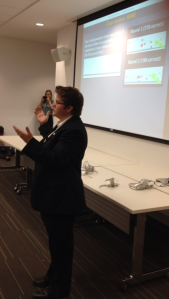Ready to turn your students’ worlds right side up? Flip your classroom with Peer Instruction.
Peer Instruction is the first innovative teaching method I tried the second time teaching my “big girl” course – a graduate level seminar on educational theory at Teachers College, Columbia University. I had been working as a postdoc with Eric Mazur for a semester, and I relished the challenge of seeing if PI would work in a small, social science course with masters and doctoral students. There were no databases of questions or ConcepTests available or user manuals for my area. And to my knowledge, no one in my department had used the method. Despite these obstacles, I was determined to give PI a go. After running the first ConcepTest on the first day of class, the classroom was absolutely electric, students were engaged; I was dumbfounded. PI worked, and I never went back to traditional lecture.
Once I had decided to use PI, my next thought was – “OK, so how do I get started?” Turns out, this is one of the most popular questions posed by members of the Peer Instruction Network . Hamizah who teaches engineering in Malaysia asks “How do I go about starting with Peer Instruction?” And Chris who teaches management in Virginia asks: “How do you get started?”
The basic purpose of education is to prepare students to use their learning outside of the classroom—that is to transfer knowledge learned in one context to new or unfamiliar situations. However, in most classroom teaching, we don’t give students enough practice transferring knowledge; we usually ask them to do that part at home and during class, focus on the easier part of information delivery through lecture. One goal of Peer Instruction (PI) is to revolutionize students’ learning experiences in class. In order to do this, instructors must move the easier task of direct instruction or content delivery out of the classroom and bring move extensive practice with knowledge transfer in. That’s where PI changes the learning game. “The idea is to teach by questioning rather than telling,” says Eric Mazur, the developer of PI. PI offers a low-threshold, well-researched opportunity for doing something meaningful with your flip.
In essence, to get started, you just need to adjust your approach to questioning. Here’s my quick start guide.
—
Quick Start Guide for Flipping your Classroom with Peer Instruction (Download a PDF of the Guide Here – also available in Dutch, Spanish, French, Portuguese, Chinese, Japanese, and Korean)
PREP STEP. PICK A RESPONSE TOOL
Most of class time in a PI course is spent interacting with questions, called ConcepTests. You need a way to deliver and collect student responses to these questions. Decide if you want to go low-tech or high-tech to pose questions in class. Either way works. “It’s not the technology, it’s the pedagogy,” says Eric.
A. Low-tech options
- Have students hold fingers against chest to display answer choices 1-5
- Have students use 8×10 colored, lettered flashcards
B. High-tech options
- Clickers
- Web-based polling tools
BEFORE CLASS
1. PICK ONE CONCEPT
You can use PI with any topic, concept, or idea. Questions that work the best are usually those that address concepts or ideas students find tricky, difficult, or often misunderstand and are key to deep understanding of the subject or discipline. For this guide, we consider flipping just a single concept or idea.
2. FACILITATE A DELIVERY ACTIVITY
To use PI in class, you need to move delivery of information out of class.
A. Assign a reading, video, or activity for students to complete outside of class that introduces your students to the concept or idea in Step 1. You can create your own video lesson for them to watch, if you like.
B. Solicit feedback from students on coverage activity: Require students to respond to i) one or two conceptually-based questions students can get right if they have done the activity. Decidedly not plug and chug or repetition questions students could answer by skimming and ii) one feedback question that asks: “What did you find most confusing or difficult about what you read (or watched, etc)?
C. Analyze that feedback for common themes in student misunderstanding or misconception about the concept.
We use Just-in-Time Teaching to facilitate delivery activities.
3. PREP QUESTIONS FOR USE IN CLASS
You need at least one question to run PI in class. Select questions that will help elicit, confront, and resolve students’ misconceptions, misunderstandings, or difficulties (see McDermott) that emerged in Step 2c.
A. Use an already existing question – Find and access over 7,000 questions for free at www.lcatalytics.com.
OR
B. Write your own question – Need help? To come up with ideas for questions, you can use the prompt cycle below. You can also get some ideas for writing effective questions for evaluating deep learning here.
Pertaining to the concept you picked in Step 1:
- Prompt 1:Students indicated they are having difficulty understanding that…or doing ….
- Prompt 2: Students must be able to…or know that…
- Prompt 3: About this concept, students often misunderstand that….or have difficultly with…or incorrectly think that…. [use those as your answer choices if you plan to deliver a multiple choice question]
- Prompt 4: What kind of question could I pose to elicit these misunderstandings, difficulties, or misconceptions? [use this as your question stem]
In-Class
4. IMPLEMENT PEER INSTRUCTION
For each concept, idea, or topic:
A. Set the stage
- Give a brief 2-5 minute presentation, for example to set the stage or put the concept in context. Hint: Don’t give away the answer in your presentation unless you are just trying to warm students up or test if they are paying attention. My favorite kinds of ConcepTests are knowledge transfer questions, where students have to apply what they have just learned in a new or different context in order to respond to the question.
B. Pose question
- Pose your question to students.
- Give students time to think about their answer, individually.
- Ask students to respond using the tool you selected in the prep step.
- Ask students to find a peer with a different answer and convince them of their response (Peer Instruction!)
- Have students respond again
- Analyze feedback
C. Provide closure
- Explain the correct answer – either yourself or asking for student volunteers.
5. REPEAT CYCLE WITH NEXT CONCEPT
Take it from the top.





Peter Hennevanger
Also available in DUTCH now. Ook in het Nederlands beschikbaar.